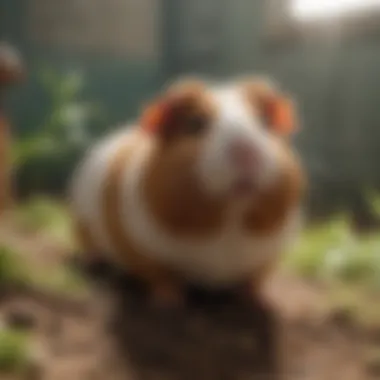Potty Training Guinea Pigs: Expert Tips and Techniques


Intro
Potty training a guinea pig can seem daunting at first, but with the right approach, it becomes manageable. Understanding the behavior of these small animals is crucial. They tend to have specific places they prefer to relieve themselves. By recognizing these habits, pet owners can create a training strategy that fits their guinea pig's needs. This guide aims to provide clear insights into the various aspects of potty training guinea pigs, from essential materials to behavioral cues and troubleshooting tips. Through systematic training, one can maintain a clean living environment and foster a stronger bond with their pet.
Pet Care and Grooming
Taking care of a guinea pig goes beyond just feeding them and cleaning their cage. Regular care is necessary to ensure their overall well-being and comfort. Proper grooming not only makes the guinea pig look good but also contributes to their health.
Importance of Regular Care
Regular care of guinea pigs helps in maintaining their hygiene. It is essential to check their fur for tangles and debris. A weekly grooming session can aid in minimizing shedding, which in turn maintains cleanliness in their living area. Also, regular handling of the pet can help in monitoring their health, as any changes can be noticed easily.
Grooming Techniques by Pet Type
Guinea pigs have varying fur types, which may require different grooming techniques. Short-haired guinea pigs need less grooming compared to long-haired types. For short-haired breeds, brushing once a week is adequate. In contrast, any long-haired guinea pig benefits from daily brushing to prevent matting and remove dirt. Gentle brushing techniques should be employed to ensure comfort.
Tools and Products Recommendations
When grooming guinea pigs, specific tools can make the job easier. A soft-bristled brush is crucial for both short and long-haired pigs. Additionally, a fine-toothed comb can help to remove tangles from longer fur. Nail clippers designed for small animals are necessary for regular nail trimming. Finally, a small pet vacuum can assist in cleaning up loose fur from the environment.
Seasonal Care Tips
Seasonal changes can impact the care routine for guinea pigs. During warmer months, ensure that they have plenty of fresh water and provide shady spots in their environment to avoid overheating. In colder months, bedding should be increased to keep them warm, along with ensuring their living space is draft-free. Monitoring their health during these seasons is paramount as temperature extremes can lead to stress and illness.
Health and Nutrition
Healthy guinea pigs require a proper understanding of their nutritional needs and potential health problems. An appropriate diet not only supports their growth but can also minimize medical issues.
Understanding Pet Nutrition
Guinea pigs need a balanced diet rich in vitamin C. Hay, especially timothy hay, should make up the majority of their diet. Fresh vegetables and pellets formulated for guinea pigs complement their diet. Avoid feeding them foods high in sugar and fat to ensure their health.
Common Health Issues by Species
Guinea pigs are prone to some common health issues, such as dental problems and respiratory infections. Regular check-ups by a veterinary professional are essential. Observing any changes in eating, grooming, or behavior helps catch potential problems early.
Preventive Care and Regular Check-Ups
Preventive care is key to maintaining health. Flea treatments and vaccinations may be necessary based on the living environment. Schedule regular veterinary visits to monitor weight and dental health.
Food and Dietary Advice
Introducing new foods gradually helps in avoiding digestive troubles. Always ensure that fresh vegetables are clean and pesticide-free. A mix of leafy greens should be provided, along with a small portion of pellets as per recommendations from a vet.
Behavioral Training
Positive reinforcement is an effective method for training guinea pigs. This technique can be used effectively for potty training as well.
Basics of Positive Reinforcement
Positive reinforcement involves rewarding desired behaviors, which strengthens the likelihood of those behaviors recurring. Offering treats or verbal praise when the guinea pig uses their designated potty area can encourage good habits.
Training Techniques Users Can Apply
To train a guinea pig, start by placing a litter box in the area where they naturally relieve themselves. Use materials they are familiar with to create the box. As they begin using it regularly, reward them with treats. Consistency is key here; patience is vital as some guinea pigs may take longer to adapt to the new routine.
Managing Behavioral Issues


If a guinea pig resists using the designated potty area, it may be helpful to examine the situational factors. Ensure the cleaning materials used around the litter box do not deter them from using it.
Importance of Socialization
Socialization is important for guinea pigs. They are social creatures and enjoy company. Regular handling and interaction help reduce stress and build trust. A well-socialized guinea pig may adapt better to training.
Engaging Activities and Enrichment
Guinea pigs thrive on mental stimulation. Engaging them with activities and toys is crucial to keeping their environment interesting.
Fun Games to Play with Your Pet
Interactive games such as hide-and-seek or target training can engage their minds. These activities promote exercise while forging a deeper bond between the pet and the owner.
DIY Toys and Activities
Creating toys from safe household items can promote creativity. Cardboard tubes or paper bags filled with hay provide entertainment and mental challenges. Always ensure that any materials used are safe and non-toxic to pets.
Importance of Mental Stimulation
Providing a variety of toys and changing them regularly can prevent boredom. Guinea pigs enjoy foraging, so hiding food in different areas can encourage natural behaviors.
Outdoor Adventures and Exploration
When weather permits, allowing guinea pigs to explore a safe environment under supervision can promote physical and mental health. Ensure that they remain protected from predators and extreme temperatures.
Resources and Community Engagement
In the digital age, finding resources for guinea pig care is easier. Books, forums, and community groups offer access to vital information.
Recommended Books and Websites
Educational books specifically about guinea pig behavior and care are crucial for new owners. Websites like en.wikipedia.org and britannica.com offer detailed information on pet care and responsible ownership.
Forums and Groups for Pet Owners
Engaging with community forums like reddit.com or dedicated Facebook groups can provide support and tips from seasoned owners. These platforms often have information on competitions and events that can involve guinea pigs.
Finding Local Services and Classes
Local veterinarians specializing in exotic pets can play a vital role in healthcare. Additionally, finding trainers skilled in small animal behavior can provide valuable insights.
Encouraging Community Sharing and Contributions
Encouraging a sense of community among pet owners can lead to knowledge sharing. Organizing local meetups can help socialize guinea pigs while building friendships among pet owners.
In summary, understanding guinea pig behavior, providing proper care, and employing the right training techniques can greatly improve both the pet's and owner's experience. This comprehensive guide is intended to support every step of the potty training process and enhance companionship.
Prologue to Guinea Pig Potty Training
Potty training guinea pigs is essential for creating a harmonious living environment for both pets and their owners. Understanding this process not only improves cleanliness but also enhances the bond between pet and caregiver. This section aims to explore why potty training is vital and how it impacts the overall management of these small animals.
Understanding Guinea Pig Behavior
Guinea pigs exhibit distinct behaviors that are essential to grasp when considering potty training. They are social creatures and prefer to establish routines. Observing their natural tendencies can aid in determining when they need to relieve themselves. Common behaviors include sniffing the ground, circling, or moving restlessly. These instincts can be harnessed by pet owners to facilitate a more successful potty training experience.
As prey animals, guinea pigs can be easily stressed. Therefore, any changes in their environment or routine may influence their behavior. Understanding these nuances can help owners predict when their pets may need to use the designated potty area.


Importance of Potty Training
The significance of potty training guinea pigs cannot be overstated. First and foremost, it greatly minimizes mess and odor within their enclosure. When guinea pigs are taught where to go, it reduces the frequency of cleaning required. A clean environment not only promotes hygiene but also contributes to the well-being of your pet.
Moreover, potty training encourages a structured living arrangement. By establishing specific areas for waste, owners can observe their pets’ habits, which is key in detecting possible health issues. Regular patterns in behavior may highlight problems like urinary tract infections or digestive concerns. Thus, potty training serves as a preventive measure for potential health risks.
It is also worthwhile to note that this training fosters communication between guinea pig and owner. By recognizing and responding to the guinea pig's behavioral signals, the bond can strengthen. This enhances the overall companionship experience, making both pets and owners happier.
The impact of potty training extends well beyond cleanliness; it enriches the relationship between pet and owner, facilitating better communication and understanding.
Training Techniques
Training techniques play a crucial role in the potty training process for guinea pigs. These methods help establish clear communication between the pet owner and the guinea pig. Understanding how to introduce specific training elements can enhance the overall experience for both parties. The right techniques can lead to successful potty training, resulting in a cleaner living space and a more enjoyable companionship.
Introducing the Potty Box
Introducing the potty box is one of the first steps in the potty training journey. Choosing a suitable box size is vital. The box should be spacious yet secure enough to provide comfort. Placing it in a quiet area where the guinea pig regularly spends time increases the chance of it being used. The right placement can help the guinea pig associate the location with relief. Ensure the box is filled with appropriate litter, as this encourages usage. Guinea pigs often prefer a specific type of litter like paper or aspen shavings. Using an enticing scent within the box can attract them, making it easier to establish the habit.
Using Positive Reinforcement
Types of rewards
Positive reinforcement is a core tenet of successful training. Using treats as rewards is common practice. Treats for guinea pigs can include small pieces of vegetables or their favorite fruits. The key characteristic of rewards is their immediate availability after a successful behavior. This direct connection fosters a positive association with using the potty box. Unlike punishment, which can create fear, rewards encourage repeat behavior. The advantage lies in the guinea pig's ability to learn in a stress-free environment.
Timing and consistency
Timing and consistency are essential in the training process. Immediate praise or treats after the desired action reinforces the behavior in the guinea pig's mind. It helps them understand that such actions lead to positive outcomes. Being consistent in your approach ensures that the guinea pig recognizes the purpose of the potty box. If the rewards come at varying times, it may confuse the pet, hindering progress. Consistency creates a routine that helps the guinea pig feel secure, aiding in the overall training adequacy.
Recognizing Behavioral Cues
Signs they need to go
Recognizing signs that indicate a guinea pig needs to relieve itself is crucial to successful potty training. Common signs may include sniffing the ground, circling the area, or becoming restless. Understanding these cues allows owners to guide their pets towards the potty box effectively. This recognition enhances communication and accelerates the training process. Knowing when your guinea pig needs to go makes it easier to prevent accidents. The advantage here is that the pet owner becomes proactive rather than reactive.
Establishing a routine
Establishing a routine helps synchronize the guinea pig’s natural habits with training efforts. Creating specific times during day when the pet is likely to need the potty enhances success rates. A routine can incorporate set feeding times and play periods. This predictability helps the guinea pig develop an understanding of when to use the potty box. The unique feature of this approach is that it helps both the pet and owner set expectations. A downside, however, is that a rigid routine may not account for unexpected changes in behavior or health, making observation crucial.
Maintaining a Clean Environment
A clean environment is crucial for keeping guinea pigs healthy and happy. It affects their physical well-being, minimizes unpleasant odors, and contributes to effective potty training. A clean space can enhance the bond between the pet and owner, allowing both to feel more comfortable.
When guinea pigs live in a tidy area, they are less likely to experience stress. Clean surroundings discourage the buildup of bacteria, leading to fewer health issues. Recognizing the link between cleanliness and overall pet happiness is vital for responsible pet ownership.
Daily Cleaning Routines
Establishing a daily cleaning routine is essential. It ensures that waste does not accumulate, which can cause odors and health problems. A few key tasks should be part of this routine:
- Remove droppings from the litter box and surrounding areas. This should be done at least once a day.
- Replace the litter in the potty box with fresh material. Use a dust-free, absorbent litter that is safe for guinea pigs.
- Spot clean bedding and surfaces where the guinea pig spends time.
- Wash food and water dishes to prevent bacterial growth.
Creating a simple checklist can help keep this task organized. Regular cleaning leads to a more pleasant living environment for both the guinea pig and the owner.
Addressing Accidents Effectively
Accidents are bound to happen during potty training. It is crucial to respond calmly and constructively. Here are some effective strategies to handle such situations:
- Clean the accident site immediately. Use a pet-friendly cleaner to remove any lingering scent, as guinea pigs may return to the same spot otherwise.
- Avoid punishment. Punishing the guinea pig can lead to fear and anxiety. Focus instead on reinforcing positive behavior when they use the designated potty area.
- Analyze the situation. If accidents occur frequently in specific areas, consider adjusting the litter box's location to better meet their needs.


By addressing accidents calmly, owners can help their guinea pigs adjust better while promoting consistent potty behavior.
Keeping Their Living Space Comfortable
The comfort of a guinea pig's living space directly affects their behavior and health. This involves more than cleanliness; it also requires the right elements:
- Provide adequate bedding to ensure comfort. Select absorbent, soft bedding materials that allow for burrowing.
- Ensure proper ventilation to maintain air quality. A well-ventilated area helps reduce odors and keeps the climate suitable.
- Maintain stable temperatures. Guinea pigs are sensitive to heat. Ensure their living area is not exposed to direct sunlight or drafty areas.
A comfortable living environment encourages guinea pigs to engage in natural behaviors, while also giving them a sense of security. Balancing cleanliness and comfort is essential for a thriving guinea pig.
In summary, maintaining a clean environment is a multi-faceted task requiring daily commitment. Adopting effective cleaning routines, addressing accidents with care, and ensuring overall comfort can significantly enhance the experience of owning a guinea pig.
Common Challenges
Potty training guinea pigs can be a rewarding experience, but it is not without its obstacles. Understanding common challenges in this process is crucial for ensuring success. These challenges range from the guinea pig's natural behaviors to the changes in their environment. Knowing how to address these issues can help pet owners maintain a cleaner living space while also fostering a strong bond with their pets.
Dealing with Non-compliance
Non-compliance can be one of the most frustrating aspects of potty training guinea pigs. Sometimes, despite the best efforts of the owner, the guinea pig may refuse to use the designated potty area. It is essential to recognize that this behavior is not a reflection of a lack of intelligence or inability to learn. Instead, it may indicate a need for adjustments in the training method or environment.
To effectively deal with non-compliance, consider the following strategies:
- Be patient: Changing a behavior takes time, and sudden results are rare.
- Reassess the training box: Ensure the box is appealing and appropriately sized for your guinea pig.
- Reinforce positive behavior: Consistently reward them when they use the potty.
Addressing Stress Factors
Stress is a significant contributor to behaviors that can hinder potty training. Guinea pigs are sensitive creatures, and various stress factors can affect their willingness to use the potty. Recognizing and addressing these factors is vital for creating a conducive training environment.
Environmental changes
Environmental changes can dramatically impact a guinea pig's behavior. This includes anything from moving their cage to altering the arrangement of their environment. Guinea pigs thrive in stable settings. When their surroundings change frequently, they might feel anxious or disoriented, leading to reluctance in using the potty box.
Some key aspects of environmental changes include:
- Consistency in their space: It helps them feel secure and reduces anxiety.
- Positioning of the potty box: Ensure it is placed in a familiar area, as relocating it may confuse them.
- Noise levels: High noise can deter them from using their potty.
New pets or family members
Introducing a new pet or even a new family member can create stress for a guinea pig. These changes can disrupt their routine and comfort levels. The presence of a new animal may also lead to dominant behavior or territorial disputes, complicating potty training. It is essential to approach these changes with care.
When dealing with new pets or family members, remember:
- Gradual introductions: Allow time for both pets to acclimate to each other's presence.
- Maintain routines as much as possible: This can help reduce stress.
- Monitor interactions: Ensure that neither pet is overly aggressive or territorial, as this can affect overall morale and behavior.
By addressing these challenges directly, owners can create a peaceful atmosphere conducive to successful potty training. Success in potty training leads to a cleaner living space and a deeper connection with the pet.
Ending
Potty training guinea pigs is not just about teaching them where to relieve themselves. It plays an important role in the overall well-being of both the pet and the owner. This guide has outlined effective training methods, highlighted challenges, and discussed the benefits that come from consistent efforts in potty training.
Long-term Benefits of Potty Training
Successfully potty training a guinea pig can result in various long-term advantages. First, it helps maintain a cleaner living environment. By teaching a guinea pig to use a designated area, the likelihood of finding scattered droppings around their habitat decreases significantly. This cleanliness not only is more pleasant for owners but also promotes better health for the pet.
Moreover, a trained guinea pig often develops a more structured routine, which can enhance their overall behavior. When they understand where they are supposed to go, it can reduce stress and confusion. In addition, it may lead to better bonding between the owner and pet. A pet that is comfortable with its habits is often more content and affectionate.
Lastly, the skills acquired through potty training can be applicable when introducing new areas or adapting to new environments, as the pet learns to retain some control over their actions. Therefore, providing long-term benefits unfolds in the form of behavioral consistency and a nurturing relationship.
Encouraging Lifelong Habits
To instill the importance of proper potty habits in a guinea pig, it is crucial to reinforce these behaviors consistently. Owners should celebrate small victories and use positive reinforcement to encourage their pets. This could mean offering a treat or gentle praise when the guinea pig uses the potty box correctly.
Regular routines work wonders. By establishing specific times for feeding and play, owners can predict when their guinea pig may need to use the potty. Establishing a regular schedule helps the pig learn when going to the designated spot is expected.
An effective strategy is to gradually transition from training stages to a more relaxed approach after the behavior becomes stable. Continuing to reward good habits, even after successful training, will help ensure that these behaviors persist. Lifelong habits become ingrained when positive experiences are consistently paired with desired actions.















